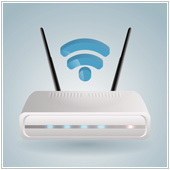 There are many different pieces of technical equipment most businesses need in order to operate successfully, with one of the most essential being the wireless router. Routers allow one network connection to essentially be split into many and then shared by different users and devices, often over a Wi-Fi connection. If you are looking for a new Wi-Fi router for your office there are some important features you should be aware of.
There are many different pieces of technical equipment most businesses need in order to operate successfully, with one of the most essential being the wireless router. Routers allow one network connection to essentially be split into many and then shared by different users and devices, often over a Wi-Fi connection. If you are looking for a new Wi-Fi router for your office there are some important features you should be aware of.
Essential features
For the vast majority of users, there are five main features that all wireless routers must have in order to make them useful in the office. They are:
- Network type – Look at any router and you will quickly see that there are a number of different networks available. The four most commonly found are 802.1b, 802.1g, 802.1n, and 802.11ac. These designations are for how fast the router can transfer wireless data, with 802.11ac being the fastest of these four. Most offices should be able to get by on n routers, but those who have users connecting via Wi-Fi and cable may do better with 802.11ac routers – which are backward compatible with other slower network versions.
- Throughput – This is closely associated with the router’s network type, and is usually one of the first things listed on router boxes and specifications. To spot the router’s throughput, look for Mbps. This indicates the speed at which the router is supposed to transmit data from your connection to users. It is important to note here that if you have a 100Mbps Internet connection, but buy a router that is only say 80 Mbps, then the total speed will be the lower figure, 80Mbps. Therefore, it would be a good idea to get a router with a higher throughput, or a close throughput, to your main Internet connection.
- Range – This is particularly important for users who will be connecting via Wi-Fi, as they will likely not be sitting right beside the router. Generally speaking, the further you are from your router, the slower and weaker your connection will be. As a rule of thumb: 802.11ac and n routers will offer the strongest connections and greatest range. But this will all depend on where the router is placed and any natural barriers like concrete walls, etc.
- Bands – On every single router’s box you will see numbers like 5Ghz and 2.4Ghz. These indicate the wireless radios on the router. A dual-band router will have both a 5Ghz and 2.4Ghz radio which allows devices to connect to different bands so as not to overload a connection. Those who connect to a 5Ghz band will generally have better performance, but the broadcast range will be much shorter than the 2.4Ghz radio.
- QoS – Quality of Service is a newer feature that allows the router administrator to limit certain types of traffic. For example, you can use the QoS feature of a router to completely block all torrent traffic, or to limit it so that other users can have equal bandwidth. Not every router has this ability, but it is a highly beneficial feature for office routers.
Useful features
As well as the above features, which are essential for business Wi-Fi routers, there are also some useful features that may help improve overall speeds and usability. Here are three of the most useful, but not essential:
- Beam-forming – This is a newer feature being introduced in many mid to high-end routers. It is a form of signal technology that allows for better throughput in dead areas of a business or home. In other words, it can help improve the connection quality with devices behind solid walls, or in rooms with high amounts of interference. By utilizing this technology, routers can see where connection is weak and act to improve it. While this is available on routers with many network types, it is really only useful with routers running 802.11ac, so if you have devices compatible with 802.11ac, then this feature could help.
- MIMO – Multiple-Input, Multiple-Output is the use of multiple antennas to increase performance and overall throughput. Most modern routers don’t actually use multiple antennas or extra antennas to increase performance, instead utilizing this concept to ensure that more devices can connect to one router with less interference and better performance.
- Antennas – Some routers, especially those geared towards home use, don’t have physical antennas, while other higher-end routers do. With many wireless routers, the idea behind antennas is that they allow the direction of the best connection to be configured. It can be easy to think that these antennas will help improve connection, but when it comes to real-world tests, there is often only a nominal improvement if the antennas are configured and aimed properly.
While these features can help improve the overall connectivity and speed of a wireless network, they are not necessary for most business users. If you are going to be tweaking networks however, then these may help. Beyond that, concepts like beam-forming only work well if you have a wealth of devices that are 802.11ac compatible and these are still less popular than devices that are say 802.1n compatible.
Features to watch out for
There are a number of router features that manufacturers often tout as essential, important, etc., when in reality these features are often more about marketing and will pose little use to the vast majority of users.
- Routers with advertised processor speeds – With many pieces of equipment, the processor speed is an important indicator as to how fast it will run, and how well systems will run. With routers however, there is usually a small requirement for processing power. Sure, some features like firewalls require processing power, but the vast majority of routers have the power to run these. Therefore, advertised processor speeds with Wi-Fi routers offer no realizable benefit to the majority of users.
- Tri-band – While many routers have dual broadcasting bands, some newer ones are now tri-band. The idea and marketing behind this is that with a third band, throughput can be dramatically increased and this is often reflected in the speeds manufacturers say these routers can offer. In reality however, this often isn’t the case, as all this extra band really does is allow for more devices to connect. You will most likely not see an increase in overall connection speed.
- Patented or trademarked features – Almost every router these days will have individual features (also known as proprietary technology) that the manufacturer includes with the idea that it makes the router that much better, or at least uniquely different, than any other. While many of these features can be useful to some users, they should not be the main reason to select a router.
How do I pick the best router?
Go to any hardware retailer and you will quickly find that the sheer number of wireless routers out there is overwhelming. Sure, they all do the same thing, but some will be better than others. One thing to try is to look at the user submitted reviews of different routers online. While the manufacturers may claim one thing, it is the real-world users who can shed the best insight into products. Try to find more business-oriented reviews rather than views based on domestic use.
What we recommend is to contact us. We can work with you to help you find and set up the best router for your business. Get in touch today to learn more.

